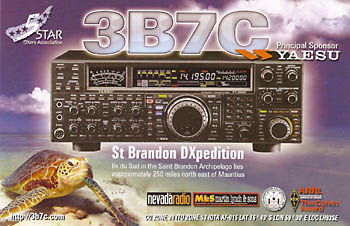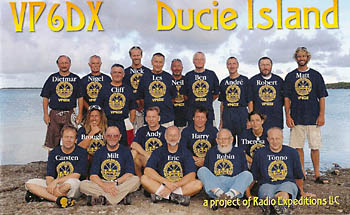Design Qsl Card for Internet Use Only
How to send and receive QSL cards

3B7C St Brandon Island QSL card
Sending and receiving QSL cards is a traditional part of the amateur radio hobby
Even in these days of the internet and email, many hams enjoy collecting QSLs. They can then confirm that a contact was made—which can be essential for some awards—and the cards can be very attractive in their own right.
The term "QSL" comes from the international Q code and means "I confirm receipt of your transmission". A QSL card is therefore a written confirmation.
The sending of QSL cards dates back to the 1920s when AM radio broadcasts were still a novelty and stations wanted to know how far away they were being received.
Radio amateurs were quick to adopt the exchange of QSL cards too and many of the older cards are now highly sought after.
Each card contains details about one or more contacts, the station and its operator. This usually includes the call sign of both stations participating in the contact, the time and date when it occurred (usually specified in UTC), the radio frequency or band used, the mode of transmission, and a signal report.
The International Amateur Radio Union and its member societies recommend a maximum size of 3½ by 5½ inches (140 mm by 90 mm) for the card, although some cards (especially from rare DXpeditions) can be a gate-fold design with multiple pages.
Cards do not have to be pictorial – some are just plain text. Others have a photograph of the operator, or his locality or interests.
There are many specialist QSL printers around, or you you can create and print your own if you don't think you will be sending many.
There are two ways of sending and receiving physical QSL cards – via a bureau or direct.
QSLing via the bureau
The bureau is the easiest and cheapest way to send and receive cards. RSGB members send their cards to a central point where they are then sorted and despatched around the world. Likewise, you can lodge envelopes with your sub-manager and receive your cards "via the bureau".
Note the address you send your envelopes to receive cards will not be the same as the address you use to send them!
When sending cards, each batch must contain proof of RSGB membership that is no more than three months old. This is the address label and identification numbers cut from the bag used to post RadCom.
Your cards must also be sorted in a specific way – see the QSL section for more details.
When receiving cards, to save money you can write "Wait 10" or whatever you choose on the envelope and your sub-manager will wait until your envelope is full before sending it.
It is usual to lodge a number of stamped, self-addressed envelopes with your sub-manager with "1 of 5, "2 of 5" etc marked on them so that you know when you need to send new ones. But do make sure you have sufficient postage on the envelopes for the appropriate weight/size.
There are various QSL sub-managers who look after specific callsign ranges – you will need to check to see who looks after you. If you are not a member of the RSGB, but would like to receive QSLs via the RSGB Bureau you can, but there is a charge for doing so. RSGB members receive the service free of charge.
You can find out more about QSLing on the special QSL services page on the RSGB web site.
QSLing Direct

VP6DX Ducie Island QSL card
Some people prefer to get their QSL cards direct from the station they worked. This may be because it is a rare country and they want to make sure they get the card. Or because they are chasing an award and need the card as soon as possible.
In either case you can send your card, along with a self-addressed envelope direct to the station or their QSL manager (some stations have someone else handle their cards for them).
If QSLing direct, enclose a self-addressed envelope with your address in full, including your country. Enclose International Reply Coupons (IRCs), Dollars (at least two), or a stamped self-addressed envelope SSAE (if UK cards) to cover return postage costs.
If using IRCs (which are available from larger post offices) make sure they haven't expired. To a large extent, US Dollars are a universally-accepted method of payment for QSL cards, but they are prone to being stolen when sent to some countries.
Some DXpeditions now offer a facility where you can pay for your QSL card online and have it delivered directly. This Online QSL service or OQSL is relatively new, but as long as you are in their log it is a quick way of getting a card sent to you – albeit a potentially expensive one.
QSL hints and tips
- Check the time in UTC/date/call on your cards are correct.
- Use the route given by the operator or listed on QRZ.com. The operator may tell you to QSL direct only or via his manager.
- Use dark envelopes for your outgoing and return envelopes if QSLing direct. That is, envelopes that are not see through – money has been known to go missing.
- Ensure that your return envelope is big enough. Miniature envelopes are too small.
- Write the date out in full – eg 12th October 2012. Shortened date formats can be misunderstood. That is, 12-10-12 means "12th October" to UK hams, and "10th December" to American amateurs. You could have your card returned with "NIL" written on it – "Not in Log".
- If your QSL is double sided, is your call printed on both sides? If the call is on one side and the information is on the other, it can slow down processing at the bureau.
- Is your address clear on your card/envelope? If it can't be read it might not come back.
- Is your county/locator/WAB square/IOTA number on your card? Many recipients of your card may want them for awards.
- Don't send foreign stamps – they could be out of date. IRCs or Dollars are better currency.
Electronic QSL cards
Because of the cost of sending and receiving QSL cards there has been a rise in interest in so-called electronic QSLing.
With these systems you can design a "card" online and then upload your electronic logbook in "ADIF" format. You then receive "cards" from your contacts who have done the same – if the contacts "match". That is, that the date, time, band and mode you claim you made the contact are the same as the other station's.
Note that this form of QSL is often not accepted for some awards- eg ARRL's DXCC (DX Century Club). But some, like the EQSL system, have their own award systems that are very popular.
The ARRL has its own electronic "QSL" system called Logbook of the World. With this, you don't get a physical, or even an electronic, card. But if your uploaded details match those of the station you claim to have worked you get a "credit" that can then be used for ARRL awards.
Logbook of the World is quite complex and the best thing to do is read all about it on the ARRL website using the link above.
Other pages in this section – Operating your new station:
Design Qsl Card for Internet Use Only
Source: https://rsgb.org/main/get-started-in-amateur-radio/operating-your-new-station/how-to-send-and-receive-qsl-cards/
0 Response to "Design Qsl Card for Internet Use Only"
Post a Comment